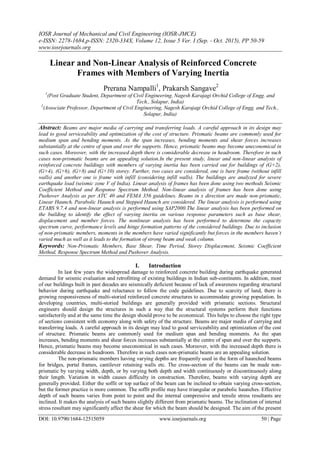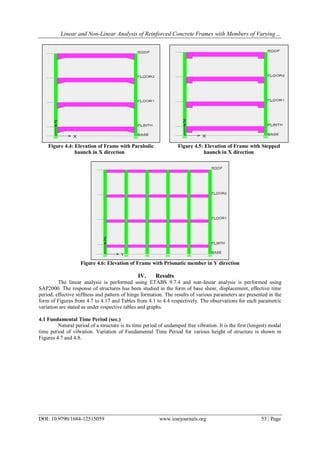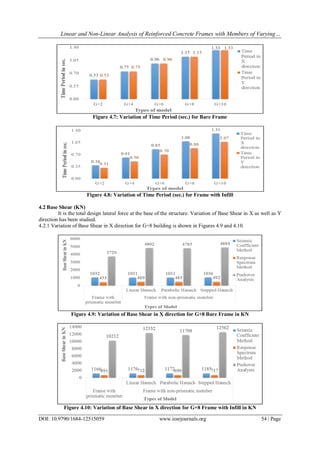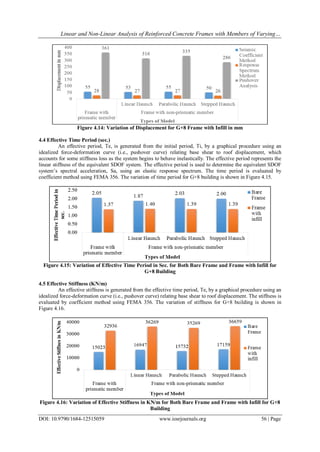1) The document presents the results of a linear and non-linear analysis of reinforced concrete frames with members of varying inertia (non-prismatic beams) for buildings ranging from G+2 to G+10 storeys.
2) Both bare frames and frames with infill walls were analyzed considering different beam cross-sections - prismatic, linear haunch, parabolic haunch, and stepped haunch.
3) The linear analysis was performed using ETABS and considered parameters like fundamental time period, base shear, and top storey displacement. The non-linear analysis used pushover analysis in SAP2000 to determine effective time period, effective stiffness, and hinge formation patterns.









![Linear and Non-Linear Analysis of Reinforced Concrete Frames with Members of Varying…
DOI: 10.9790/1684-12515059 www.iosrjournals.org 59 | Page
References
[1]. Aranda, H., I., A. and Colunga, A., T., (2008), “Cyclic behavior of reinforced concrete haunched beams failing in shear”, World
Conference on Earthquake Engineering, 1-8.
[2]. Arturo, T., C., Becerril, M. and Andres, L., (2012), “Lateral stiffness of reinforced concrete moment frames with haunched beams”,
World Conference on Earthquake Engineering, 1-10.
[3]. Ashtari, P., Rasouli, I., Sediq, H., B., (2012), “Seismic behavior of T-shape resistant frame (TRF) with different shapes of link
beams”, World Conference on Earthquake Engineering, 1-8.
[4]. Dinar, Y., Hossain, I., Biswas, R., K. and Rana, M., (2014), “Descriptive study of pushover analysis in R.C.C. structures of rigid
joint”, IOSR Journal of Mechanical and Civil Engineering, Vol.11 (1), 60-68.
[5]. Golghate K., Baradiya V. and Sharma A., (2013), Pushover analysis of 4 Storey’s reinforced concrete building, International
Journal of Latest Trends in Engineering and Technology (IJLTET),Vol. 2 (3), 80-84.
[6]. Hassaballa A. E., Fathelrahman M. Adam and Ismaeil M. A., (2013), Seismic analysis of a reinforced concrete building by response
spectrum method, IOSR Journal of Engineering, Vol.3 (9), 1-9.
[7]. Kulkarni, J., G., Kore, P., N. and Tanawade, S., B., (2013), “Analysis of multi-storey building frames subjected to gravity and
seismic loads with varying inertia”, International Journal of Engineering and Innovative Technology, Vol.2 (10), 132-138.
[8]. Pambhar D. J., (2012), Performance based pushover analysis of R.C.C. frames, International Journal of Advanced Engineering
Research and Studies, Vol. 1(3), 329-333.
[9]. Pavan K. E., Naresh A., Nagajyothi M. and Rajasekhar M., (2014), Earthquake analysis of multi storied residential building - a case
study, Int. Journal of Engineering Research and Applications, Vol. 4 (11), 59-64.
[10]. Shah M. D. and Patel S. B., (2011), Nonlinear static analysis of R.C.C. frames - Software implementation ETABS 9.7, National
Conference on Recent Trends in Engineering & Technology, 1-6.
[11]. Shahrin R. and Hossain T.R., (2011), Seismic performance evaluation of residential buildings in Dhaka city by using pushover
analysis, 4th Annual Paper Meet and 1st Civil Engineering Congress, Dhaka, Bangladesh, 279-286.
[12]. Sharma M. and Dr. Maru S., (2014), Dynamic analysis of multistoried regular building, IOSR Journal of Mechanical and Civil
Engineering (IOSR-JMCE), Vol.11 (1), 37-42.
[13]. Soltangharai V. and Mahdi T., (2012), Static and dynamic analyses of asymmetric reinforced concrete frames, World Conference on
Earthquake Engineering, 1-9.
[14]. Srinivasu A. and Dr. Panduranga Rao B., (2013), Non-linear static analysis of multi-storied building, International Journal of
Engineering Trends and Technology (IJETT), Vol. 4 (10), 4629-4633.
[15]. Wakchaure M. R. and Ped S. P., (2012), Earthquake analysis of high rise building with and without in filled walls, International
Journal of Engineering and Innovative Technology (IJEIT), Vol. 2 (2), 89-94.
[16]. Federal Emergency Management Agency, FEMA-356: Prestandard and Commentary for the Seismic Rehabilitation of Buildings,
2000, Washington DC.
[17]. Applied Technology Council, ATC-40: Seismic Evaluation and Retrofit of Concrete Buildings, 1996, California.
[18]. Agarwal, P. and Shrikhande, M., Earthquake resistant design of structures (PHI Learning Publication, 1st
Edition, 144-188,251-
326,371-391).
[19]. Junnarkar, S., B. and Shah, H., J., Mechanics of structures Vol.2 (Charotar Publication, 9th
Edition, 810-867).
[20]. Housur V., Earthquake resistant design of building structures (WILEY Publication, 1st
Edition, 125-173,197-230).
[21]. Vajirani, V., N., Ratawani, M., M. and Duggal, S., K., Analysis of structures Vol.2 (Khanna Publishers, 16th
Edition, 470-520).
[22]. Weaver, J. and Gere, J., M., Matrix analysis of framed structure (CBS Publishers and Distributor, New Delhi, 391-398).
[23]. I.S. 456-2000, Indian standard code of practice for plain and reinforced concrete (4th
Revision), Bureau of Indian standards, New
Delhi.
[24]. I.S. 1893 (Part-1)-2002, Criteria for earthquake resistant design of structure, general provision and building, Bureau of Indian
standards, New Delhi.](https://image.slidesharecdn.com/f012515059-160726082144/85/F012515059-10-320.jpg)